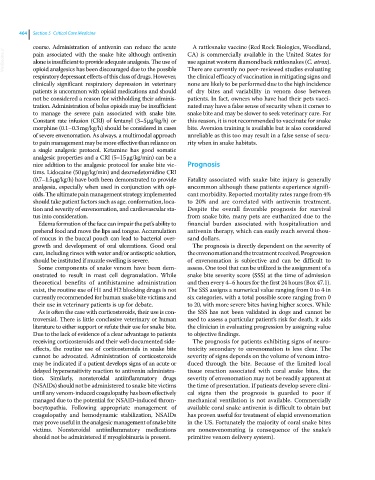Page 496 - Clinical Small Animal Internal Medicine
P. 496
464 Section 5 Critical Care Medicine
course. Administration of antivenin can reduce the acute A rattlesnake vaccine (Red Rock Biologics, Woodland,
VetBooks.ir pain associated with the snake bite although antivenin CA) is commercially available in the United States for
use against western diamondback rattlesnakes (C. atrox).
alone is insufficient to provide adequate analgesia. The use of
opioid analgesics has been discouraged due to the possible
the clinical efficacy of vaccination in mitigating signs and
respiratory depressant effects of this class of drugs. However, There are currently no peer‐reviewed studies evaluating
clinically significant respiratory depression in veterinary none are likely to be performed due to the high incidence
patients is uncommon with opioid medications and should of dry bites and variability in venom dose between
not be considered a reason for withholding their adminis- patients. In fact, owners who have had their pets vacci-
tration. Administration of bolus opioids may be insufficient nated may have a false sense of security when it comes to
to manage the severe pain associated with snake bite. snake bite and may be slower to seek veterinary care. For
Constant rate infusion (CRI) of fentanyl (3–5 μg/kg/h) or this reason, it is not recommended to vaccinate for snake
morphine (0.1–0.3 mg/kg/h) should be considered in cases bite. Aversion training is available but is also considered
of severe envenomation. As always, a multimodal approach unreliable as this too may result in a false sense of secu-
to pain management may be more effective than reliance on rity when in snake habitats.
a single analgesic protocol. Ketamine has good somatic
analgesic properties and a CRI (5–15 μg/kg/min) can be a
nice addition to the analgesic protocol for snake bite vic- Prognosis
tims. Lidocaine (50 μg/kg/min) and dexmedetomidine CRI
(0.7–1.5 μg/kg/h) have both been demonstrated to provide Fatality associated with snake bite injury is generally
analgesia, especially when used in conjunction with opi- uncommon although these patients experience signifi-
oids. The ultimate pain management strategy implemented cant morbidity. Reported mortality rates range from 4%
should take patient factors such as age, conformation, loca- to 20% and are correlated with antivenin treatment.
tion and severity of envenomation, and cardiovascular sta- Despite the overall favorable prognosis for survival
tus into consideration. from snake bite, many pets are euthanized due to the
Edema formation of the face can impair the pet’s ability to financial burden associated with hospitalization and
prehend food and move the lips and tongue. Accumulation antivenin therapy, which can easily reach several thou-
of mucus in the buccal pouch can lead to bacterial over- sand dollars.
growth and development of oral ulcerations. Good oral The prognosis is directly dependent on the severity of
care, including rinses with water and/or antiseptic solution, the envenomation and the treatment received. Progression
should be instituted if muzzle swelling is severe. of envenomation is subjective and can be difficult to
Some components of snake venom have been dem- assess. One tool that can be utilized is the assignment of a
onstrated to result in mast cell degranulation. While snake bite severity score (SSS) at the time of admission
theoretical benefits of antihistamine administration and then every 4–6 hours for the first 24 hours (Box 47.1).
exist, the routine use of H1 and H2 blocking drugs is not The SSS assigns a numerical value ranging from 0 to 4 in
currently recommended for human snake bite victims and six categories, with a total possible score ranging from 0
their use in veterinary patients is up for debate. to 20, with more severe bites having higher scores. While
As is often the case with corticosteroids, their use is con- the SSS has not been validated in dogs and cannot be
troversial. There is little conclusive veterinary or human used to assess a particular patient’s risk for death, it aids
literature to either support or refute their use for snake bite. the clinician in evaluating progression by assigning value
Due to the lack of evidence of a clear advantage to patients to objective findings.
receiving corticosteroids and their well‐documented side‐ The prognosis for patients exhibiting signs of neuro-
effects, the routine use of corticosteroids in snake bite toxicity secondary to envenomation is less clear. The
cannot be advocated. Administration of corticosteroids severity of signs depends on the volume of venom intro-
may be indicated if a patient develops signs of an acute or duced through the bite. Because of the limited local
delayed hypersensitivity reaction to antivenin administra- tissue reaction associated with coral snake bites, the
tion. Similarly, nonsteroidal antiinflammatory drugs severity of envenomation may not be readily apparent at
(NSAIDs) should not be administered to snake bite victims the time of presentation. If patients develop severe clini-
until any venom‐induced coagulopathy has been effectively cal signs then the prognosis is guarded to poor if
managed due to the potential for NSAID‐induced throm- mechanical ventilation is not available. Commercially
bocytopathia. Following appropriate management of available coral snake antivenin is difficult to obtain but
coagulopathy and hemodynamic stabilization, NSAIDs has proven useful for treatment of elapid envenomation
may prove useful in the analgesic management of snake bite in the US. Fortunately the majority of coral snake bites
victims. Nonsteroidal antiinflammatory medications are nonenvenomating (a consequence of the snake’s
should not be administered if myoglobinuria is present. primitive venom delivery system).

